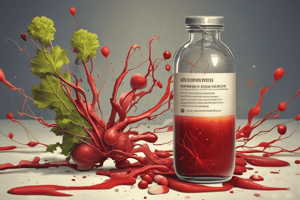Podcast
Questions and Answers
What is the main action of Vitamin E as an antioxidant?
What is the main action of Vitamin E as an antioxidant?
- Facilitates the conversion of tocopherols to tocotrienols
- Helps in the synthesis of red blood cells
- Promotes the absorption of Vitamin K
- Stops the chain reaction of free radicals (correct)
Which form of Vitamin E is most active in the body?
Which form of Vitamin E is most active in the body?
- Gamma-tocopherol
- Delta-tocopherol
- Beta-tocopherol
- Alpha-tocopherol (correct)
What is a classic sign of Vitamin E deficiency?
What is a classic sign of Vitamin E deficiency?
- Increased production of free radicals
- Decreased absorption of lipids
- Erythrocyte hemolysis (correct)
- Poor blood clotting
At what dosage has Vitamin E toxicity been observed?
At what dosage has Vitamin E toxicity been observed?
Which food sources are rich in Vitamin E?
Which food sources are rich in Vitamin E?
What are the three different forms of vitamin A that are active in the body?
What are the three different forms of vitamin A that are active in the body?
Which foods are a source of beta-carotene?
Which foods are a source of beta-carotene?
What is the UL for vitamin A intake per day?
What is the UL for vitamin A intake per day?
What deficiency can result from a lack of vitamin A?
What deficiency can result from a lack of vitamin A?
What is the primary action of vitamin K in the body?
What is the primary action of vitamin K in the body?
Which vitamin A sources contribute to daily retinol activity equivalent (RAE) recommendations?
Which vitamin A sources contribute to daily retinol activity equivalent (RAE) recommendations?
How is the vitamin A content of foods expressed in recommendations?
How is the vitamin A content of foods expressed in recommendations?
What can result from vitamin A toxicity?
What can result from vitamin A toxicity?
What is the primary plant-derived form of Vitamin K?
What is the primary plant-derived form of Vitamin K?
What is the recommended daily allowance of Vitamin K for men?
What is the recommended daily allowance of Vitamin K for men?
Which condition is associated with Vitamin K deficiency in newborns?
Which condition is associated with Vitamin K deficiency in newborns?
What is a characteristic of Vitamin K toxicity?
What is a characteristic of Vitamin K toxicity?
Which of these foods is a rich source of Vitamin D?
Which of these foods is a rich source of Vitamin D?
What deficiency condition in adults is associated with a lack of Vitamin D?
What deficiency condition in adults is associated with a lack of Vitamin D?
What is the primary role of 1,25-diOH-D3 in the body?
What is the primary role of 1,25-diOH-D3 in the body?
What can result from high doses of Vitamin D over time?
What can result from high doses of Vitamin D over time?
Flashcards
Alpha-tocopherol
Alpha-tocopherol
The most active form of vitamin E, responsible for its antioxidant effects.
Vitamin E's Role
Vitamin E's Role
Vitamin E acts as an antioxidant, protecting cells from damage caused by free radicals. It particularly safeguards polyunsaturated fatty acids.
Vitamin E Deficiency
Vitamin E Deficiency
A primary deficiency is rare, usually linked to fat malabsorption. It can lead to red blood cell breakdown due to fatty acid oxidation.
Erythrocyte Hemolysis
Erythrocyte Hemolysis
Signup and view all the flashcards
Vitamin E Toxicity
Vitamin E Toxicity
Signup and view all the flashcards
Vitamin K
Vitamin K
Signup and view all the flashcards
Phylloquinone (K1)
Phylloquinone (K1)
Signup and view all the flashcards
Menaquinone (K2)
Menaquinone (K2)
Signup and view all the flashcards
Hemorrhagic Disease
Hemorrhagic Disease
Signup and view all the flashcards
Vitamin D
Vitamin D
Signup and view all the flashcards
Vitamin D2 (Ergocalciferol)
Vitamin D2 (Ergocalciferol)
Signup and view all the flashcards
Vitamin D3 (Cholecalciferol)
Vitamin D3 (Cholecalciferol)
Signup and view all the flashcards
Rickets
Rickets
Signup and view all the flashcards
Vitamin A Forms
Vitamin A Forms
Signup and view all the flashcards
Beta-Carotene's Role
Beta-Carotene's Role
Signup and view all the flashcards
Vitamin A Food Sources
Vitamin A Food Sources
Signup and view all the flashcards
What is RAE?
What is RAE?
Signup and view all the flashcards
Vitamin K's Primary Role
Vitamin K's Primary Role
Signup and view all the flashcards
Vitamin K Name Origin
Vitamin K Name Origin
Signup and view all the flashcards
Study Notes
Vitamin E
- Vitamin E's primary antioxidant action is to protect cell membranes from damage caused by free radicals.
- The most active form of vitamin E in the body is alpha-tocopherol.
- A classic sign of Vitamin E deficiency is nerve damage.
- Vitamin E toxicity has been observed at dosages exceeding 1,000 IU daily.
- Rich sources of Vitamin E include vegetable oils, nuts, seeds, and leafy green vegetables.
Vitamin A
- The three active forms of vitamin A in the body are retinol, retinal, and retinoic acid.
- Beta-carotene is a precursor to vitamin A and is found in orange and yellow fruits and vegetables, such as carrots, sweet potatoes, and cantaloupe.
- The Upper Limit (UL) for vitamin A intake per day is 10,000 IU for adults.
- A lack of vitamin A can result in night blindness.
- Vitamin A sources that contribute to daily retinol activity equivalent (RAE) recommendations are retinol (preformed vitamin A), beta-carotene, and other provitamin A carotenoids.
- The vitamin A content of foods is expressed in recommendations as retinol activity equivalents (RAE).
- Vitamin A toxicity can result in birth defects, and bone abnormalities.
Vitamin K
- The primary action of vitamin K in the body is to help the body clot blood.
- The primary plant-derived form of Vitamin K is phylloquinone.
- The recommended daily allowance of Vitamin K for men is 120 mcg.
- A condition associated with Vitamin K deficiency in newborns is hemorrhagic disease (also known as Vitamin K deficiency bleeding).
- A rich source of Vitamin D includes fatty fish, such as salmon, tuna, and mackerel.
Vitamin D
- A deficiency condition in adults associated with a lack of Vitamin D is rickets, a condition characterized by bone softening and weakening, and osteomalacia, a condition that affects adults and involves bone softening.
- The primary role of 1,25-diOH-D3 (the active form of Vitamin D) in the body is to regulate calcium and phosphorus levels, which are crucial for bone health.
- High doses of Vitamin D over time can result in hypercalcemia (high blood calcium levels), a condition that can lead to kidney stones and other health problems.
Studying That Suits You
Use AI to generate personalized quizzes and flashcards to suit your learning preferences.




